Washability and Distribution Behaviors of Trace Elements of a High-Sulfur Coal, SW Guizhou, China
Abstract
:1. Introduction
2. Geological Setting
3. Samples and Analytical Methods
4. Results and Discussion
4.1. Float-Sink Test
4.2. Coal Washability
4.3. Organic Affinities of Trace Elements
4.4. Distribution of Trace Elements during Gravity Separation
5. Conclusions
Acknowledgements
Author Contributions
Conflicts of Interest
References
- Zhang, Q.; Tian, Y.Z.; Qiu, Y.Q.; Cao, J.X.; Xiao, T.C. Study on the washability of the Kaitai coal, Guizhou province China. Fuel Process. Technol. 2011, 92, 692–698. [Google Scholar] [CrossRef]
- Xie, G.Y.; Zhang, M.X.; Bian, B.X.; Fan, M.Q. Mineral Processing Technology; China University of Mining and Technology Press: Xuzhou, China, 2012. [Google Scholar]
- Li, C.; McLinden, C.; Fioletov, V.; Krotkov, N.; Carn, S.; Joiner, J.; Streets, D.; He, H.; Ren, X.R.; Li, Z.Q.; et al. India Is Overtaking China as the World’s Largest Emitter of Anthropogenic Sulfur Dioxide. Sci. Rep. 2017. [Google Scholar] [CrossRef] [PubMed]
- National Development and Reform Commission (NDRC). The Eleventh Five-Year Development Plan of Coal Industry; NDRC: Beijing, China, 2007. [Google Scholar]
- National Development and Reform Commission (NDRC). The Thirteenth Five-Year Development Plan of Coal Industry; NDRC: Beijing, China, 2016. [Google Scholar]
- Yang, R.D.; Liu, L.; Wei, H.R.; Cui, Y.C.; Cheng, W. Geochemical characteristics of Guizhou Permian coal measure strata and analysis of the control factors. J. Coal Sci. Eng. 2011, 17, 55–68. [Google Scholar] [CrossRef]
- Cheng, W.; Yang, R.D.; Zhang, Q.; Cui, Y.C.; Gao, J.B. Distribution characteristics, occurrence modes and controlling factors of trace elements in Late Permian coal from Bijie City, Guizhou Province. J. China Coal Soc. 2013, 38, 103–113. [Google Scholar]
- Dai, S.F.; Ren, D.Y.; Ma, S.M. The cause of endemic fluorosis in western Guizhou Province, Southwest China. Fuel 2004, 83, 2095–2098. [Google Scholar] [CrossRef]
- Dai, S.F.; Li, W.W.; Tang, Y.G.; Zhang, Y.; Feng, P. The sources, pathway, and preventive measures for fluorosis in Zhijin County, Guizhou, China. Appl. Geochem. 2007, 22, 1017–1024. [Google Scholar] [CrossRef]
- Wang, L.; Ju, Y.W.; Liu, G.J.; Chou, C.-L.; Zheng, L.G.; Qi, C.C. Selenium in Chinese coal: Distribution, occurrence and health impact. Environ. Earth Sci. 2010, 60, 1641–1651. [Google Scholar] [CrossRef]
- Yang, N.; Tang, S.H.; Zhang, S.H.; Huang, W.H.; Chen, P.; Chen, Y.Y.; Xi, Z.D.; Yuan, Y.; Wang, K.F. Fluorine in Chinese Coal: A Review of Distribution, Abundance, Modes of Occurrence, Genetic Factors and Environmental Effects. Minerals 2017, 7, 219. [Google Scholar] [CrossRef]
- Finkelman, R.B.; Tian, L.W. The health impacts of coal use in China. Int. Geol. Rev. 2017. [Google Scholar] [CrossRef]
- Cheng, W.; Zhang, Q.; Yang, R.D.; Tian, Y.Z. Occurrence modes and cleaning potential of sulfur and some trace elements in a high-sulfur coal from Pu’an coalfield, SW Guizhou, China. Environ. Earth Sci. 2014, 72, 35–46. [Google Scholar] [CrossRef]
- Vejahati, F.; Xu, Z.H.; Gupta, R. Trace elements in coal: Association with coal and minerals and their behavior during coal utilization. Fuel 2010, 89, 904–911. [Google Scholar] [CrossRef]
- Quick, W.J.; Irons, R.M.A. Trace element partitioning during the firing of washed and untreated power station coals. Fuel 2002, 81, 665–672. [Google Scholar] [CrossRef]
- Wang, W.F.; Qin, Y.; Jiang, B.; Fu, X.H. Modes of Occurrence and Cleaning Potential of Trace Elements in Coals from the Northern Ordos Basin and Shanxi Province, China. Acta Geol. Sin. 2004, 78, 960–969. [Google Scholar]
- Li, J.; Zhuang, X.G.; Querol, X. Trace element affinities in two high-Ge coals from China. Fuel 2011, 90, 240–247. [Google Scholar] [CrossRef]
- Wagner, N.J.; Tlotleng, M.T. Distribution of selected trace elements in density fractioned Waterberg coals from South Africa. Int. J. Coal Geol. 2012, 94, 225–237. [Google Scholar] [CrossRef]
- Kolker, A.; Senior, C.; Alphen, C.; Koenig, A.; Geboy, N. Mercury and trace element distribution in density separates of a South African Highveld (#4) coal: Implications for mercury reduction and preparation of export coal. Int. J. Coal Geol. 2017, 170, 7–13. [Google Scholar]
- Wang, H.; Shao, L.Y.; Hao, L.M.; Zhang, P.; Glasspool, I.J.; Wheeley, J.R.; Hilton, J. Sedimentary and sequence stratigraphy of the Lopingian (Late Permian) coal measures in southwestern China. Int. J. Coal Geol. 2011, 85, 168–183. [Google Scholar] [CrossRef]
- GB/T 212-2008. Proximate Analysis of Coal. (GB: National Standard of P.R. China). Available online: https://www.chinesestandard.net/Default.aspx?PDF-English-ID=GB/T%20212-2008 (accessed on 12 November 2017).
- GB/T 214-2007. Determination of Total Sulfur in Coal. (GB: National Standard of P.R. China). Available online: https://www.chinesestandard.net/Default.aspx?StdID=22.%09GB/T%20214-2007 (accessed on 12 November 2017).
- GB/T 478-2008. Method for float and sink analysis of coal. (GB: National Standard of P.R. China). Available online: https://www.chinesestandard.net/Default.aspx?StdID=23.%09GB/T%20478-2008 (accessed on 12 November 2017).
- Chou, C.L. Sulfur in coals: A review of geochemistry and origins. Int. J. Coal Geol. 2012, 100, 1–13. [Google Scholar] [CrossRef]
- Vassilev, S.V.; Eskenazy, G.M.; Vassilev, C.G. Behaviour of elements and minerals during preparation and combustion of the Pernik coal, Bulgaria. Fuel Process. Technol. 2001, 72, 103–129. [Google Scholar] [CrossRef]
- Dai, S.F.; Ren, D.Y.; Tang, Y.G.; Yue, M.; Hao, L.M. Concentration and distribution of elements in Late Permian coals from western Guizhou Province, China. Int. J. Coal Geol. 2005, 61, 119–137. [Google Scholar] [CrossRef]
- Geboy, N.J.; Engle, M.A.; Hower, J.C. Whole-coal versus ash basis in coal geochemistry: A mathematical approach to consistent interpretations. Int. J. Coal Geol. 2013, 113, 41–49. [Google Scholar] [CrossRef]
- Finkelman, R.B.; Palmer, C.A.; Wang, P.P. Quantification of the modes of occurrence of 42 elements in coal. Int. J. Coal Geol. 2018, 185, 138–160. [Google Scholar] [CrossRef]
- Seredin, V.V.; Dai, S.F. Coal deposits as potential alternative sources for lanthanides and yttrium. Int. J. Coal Geol. 2012, 94, 67–93. [Google Scholar] [CrossRef]
- Kang, J.; Zhao, L.; Wang, X.; Song, W.; Wang, P.; Wang, R.; Li, T.; Sun, J.; Jia, S.; Zhu, Q. Abundance and geological implication of rare earth elements and yttrium in coals from the Suhaitu Mine, Wuda Coalfield, northern China. Energy Explor. Exploit. 2014, 32, 873–889. [Google Scholar] [CrossRef]
- Lin, R.H.; Bank, T.L.; Roth, E.A.; Granite, E.J.; Soong, Y. Organic and inorganic associations of rare earth elements in central Appalachian coal. Int. J. Coal Geol. 2017, 179, 295–301. [Google Scholar] [CrossRef]
- Eskenazy, G.M. Rare earth elements in a sampled coal from the Pirin deposit, Bulgaria. Int. J. Coal Geol. 1987, 7, 301–314. [Google Scholar] [CrossRef]
- Eskenazy, G.M. Aspects of the geochemistry of rare earth elements in coal: An experimental approach. Int. J. Coal Geol. 1999, 38, 285–295. [Google Scholar] [CrossRef]
- Sonke, J.E.; Salters, V.J. Lanthanide–humic substances complexation. I. Experimental evidence for a lanthanide contraction effect. Geochim. Cosmochim. Acta. 2006, 70, 1495–1506. [Google Scholar] [CrossRef]
- Wang, W.F.; Qin, Y.; Sang, S.S.; Zhu, Y.M.; Wang, C.Y.; Weiss, D.J. Geochemistry of rare earth elements in a marine influenced coal and its solvent extracts from the Antaibao mining district, Shanxi, China. Int. J. Coal Geol. 2008, 76, 309–317. [Google Scholar] [CrossRef]
- Wang, Z.G.; Yu, X.Y.; Zhao, Z.H. Rare Earth Geochemistry; Science Press: Beijing, China, 1989; pp. 46–278. [Google Scholar]
- Dai, S.F.; Li, D.; Chou, C.-L.; Zhao, L.; Zhang, Y.; Ren, D.Y.; Ma, Y.W.; Sun, Y.Y. Mineralogy and geochemistry of boehmite-rich coals: New insights from the Haerwusu Surface Mine, Jungar Coalfield, Inner Mongolia, China. Int. J. Coal Geol. 2008, 74, 185–202. [Google Scholar] [CrossRef]
- Yang, J.Y. The periodic law of trace elements in coal—A case study of the 5# coal from the Weibei Coalfield. Sci. China Earth Sci. 2011, 54, 1542–1550. [Google Scholar]
- Swaine, D.J. Trace Elements in Coal; Butterworths: London, UK, 1990. [Google Scholar]
- Ketris, M.P.; Yudovich, Y.E. Estimation of Clarkes for Carbonaceous biolithes: Word averages for trace element contents in black shales and coals. Int. J. Coal Geol. 2009, 78, 135–148. [Google Scholar] [CrossRef]
- Dai, S.F.; Ren, D.Y.; Chou, C.-L.; Finkelman, R.B.; Seredin, V.V.; Zhou, Y.P. Geochemistry of trace elements in Chinese coals: A review of abundances, genetic types, impacts on human health, and industrial utilization. Int. J. Coal Geol. 2012, 94, 3–21. [Google Scholar] [CrossRef]
- Duan, P.P.; Wang, W.F.; Sang, S.S.; Qian, F.C.; Shao, P.; Zhao, X. Partitioning of hazardous elements during preparation of high-uranium coal from Rongyang, Guizhou, China. J. Geochem. Explor. 2018, 185, 81–92. [Google Scholar] [CrossRef]
- Dai, S.F.; Finkelman, R.B. Coal as a promising source of critical elements: Progress and future prospects. Int. J. Coal Geol. 2017. [Google Scholar] [CrossRef]
- Dai, S.F.; Yan, X.; Ward, C.R.; Hower, J.C.; Zhao, L.; Wang, X.; Zhao, L.; Ren, D.; Finkelman, R.B. Valuable elements in Chinese coals: A review. Int. Geol. Rev. 2016. [Google Scholar] [CrossRef]
- Dai, S.F.; Luo, Y.B.; Seredin, V.V.; Ward, C.R.; Hower, J.C.; Zhao, L.; Liu, S.D.; Zhao, C.L.; Tian, H.M.; Zou, J.H. Revisiting the late Permian coal from the Huayingshan, Sichuan, southwestern China: Enrichment and occurrence modes of minerals and trace elements. Int. J. Coal Geol. 2014, 122, 110–128. [Google Scholar] [CrossRef]
- Dai, S.F.; Liu, J.; Ward, C.R.; Hower, J.C.; French, D.; Jia, S.; Hood, M.M.; Garrison, T.M. Mineralogical and geochemical compositions of Late Permian coals and host rocks from the Guxu Coalfield, Sichuan Province, China, with emphasis on enrichment of rare metals. Int. J. Coal Geol. 2016, 166, 71–95. [Google Scholar] [CrossRef]
- Dai, S.F.; Zhou, Y.P.; Zhang, M.Q.; Wang, X.B.; Wang, J.M.; Song, X.L.; Jiang, Y.F.; Luo, Y.B.; Song, Z.T.; Yang, Z.; et al. A new type of Nb (Ta)–Zr(Hf)–REE–Ga polymetallic deposit in the late Permian coal-bearing strata, eastern Yunnan, southwestern China: Possible economic significance and genetic implications. Int. J. Coal Geol. 2010, 83, 55–63. [Google Scholar] [CrossRef]
- Dai, S.F.; Ward, C.R.; Graham, I.T.; French, D.; Hower, J.C.; Zhao, L.; Wang, X.B. Altered volcanic ashes in coal and coal-bearing sequences: A review of their nature and significance. Earth-Sci. Rev. 2017, 175, 44–74. [Google Scholar] [CrossRef]

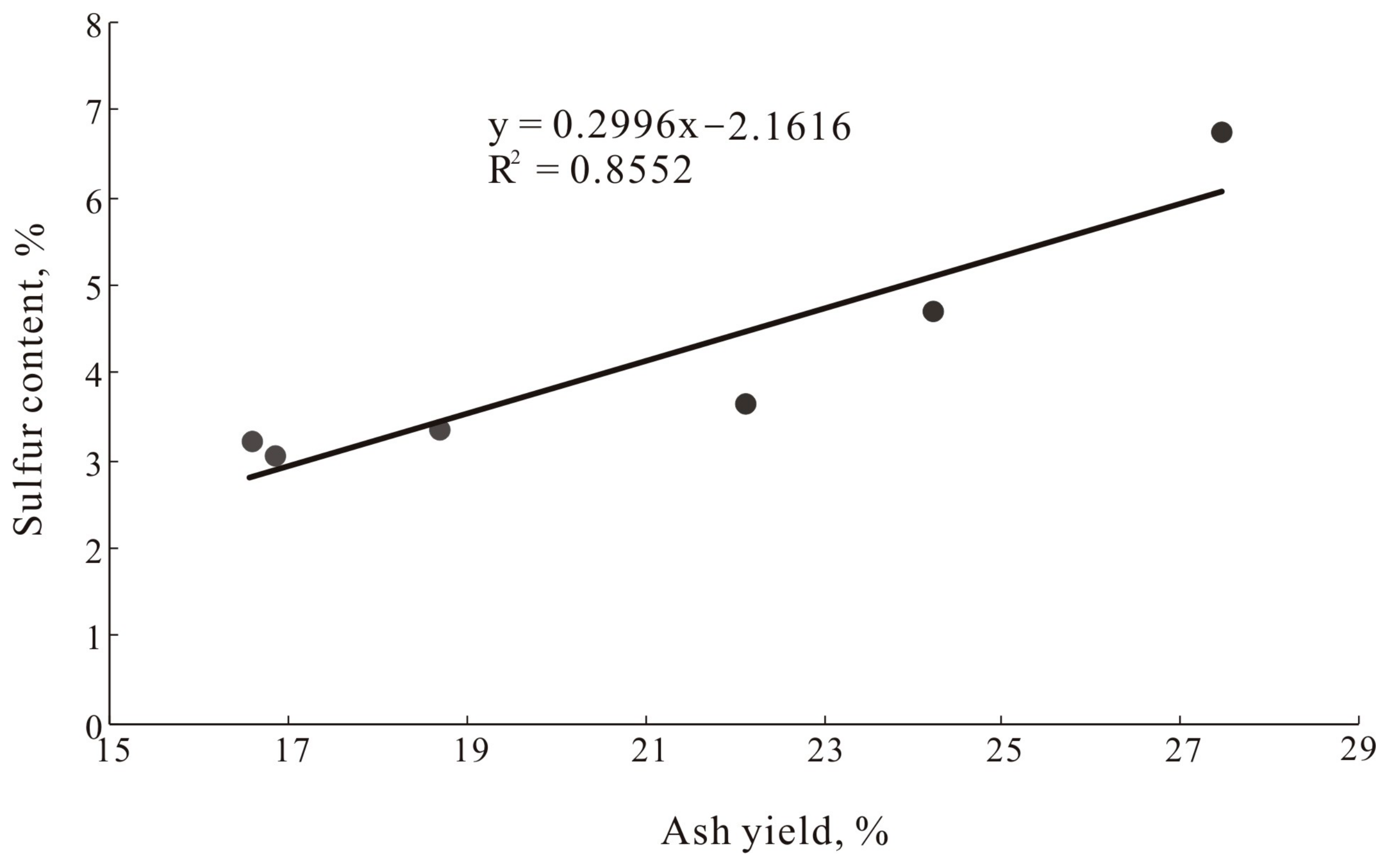
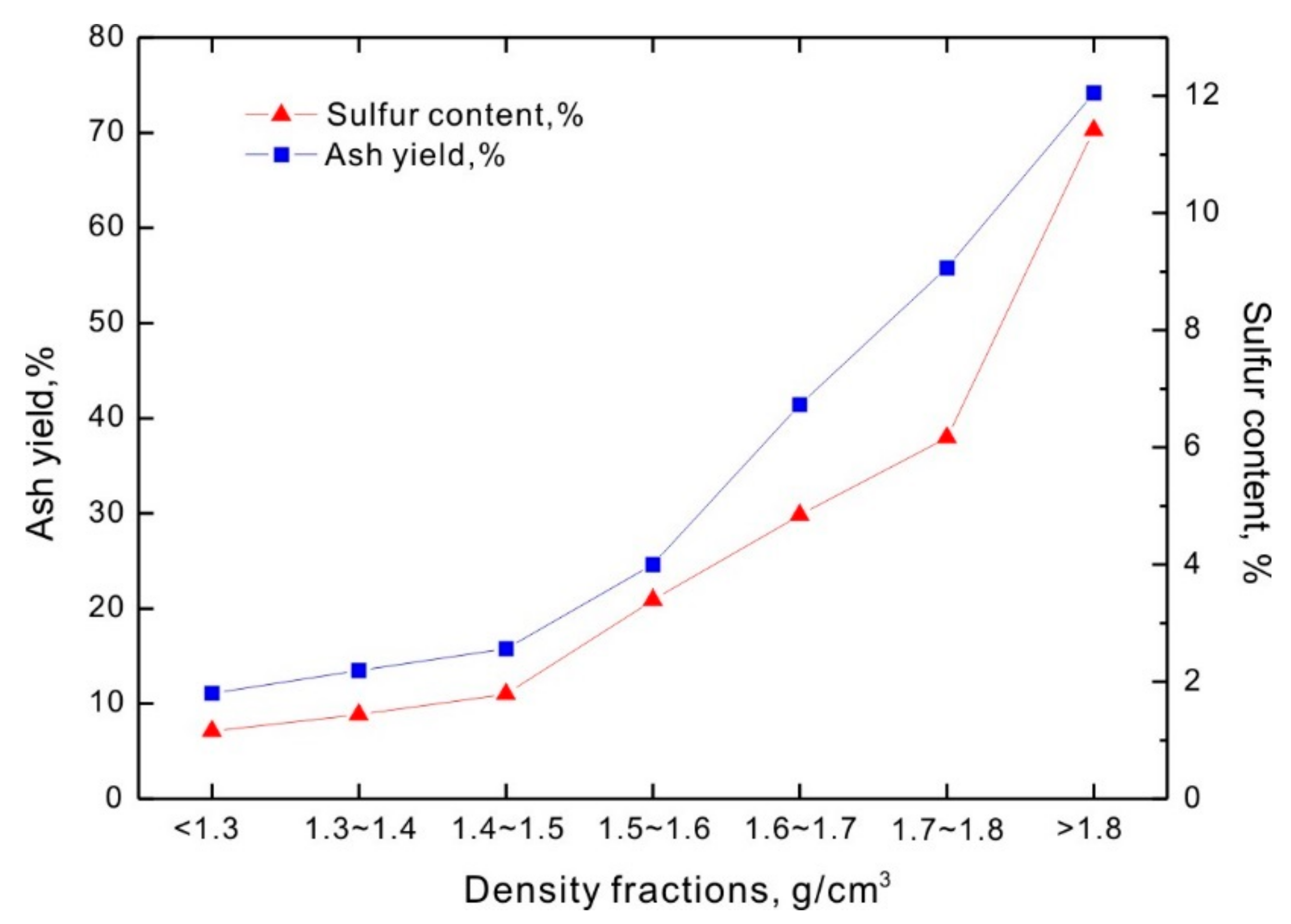
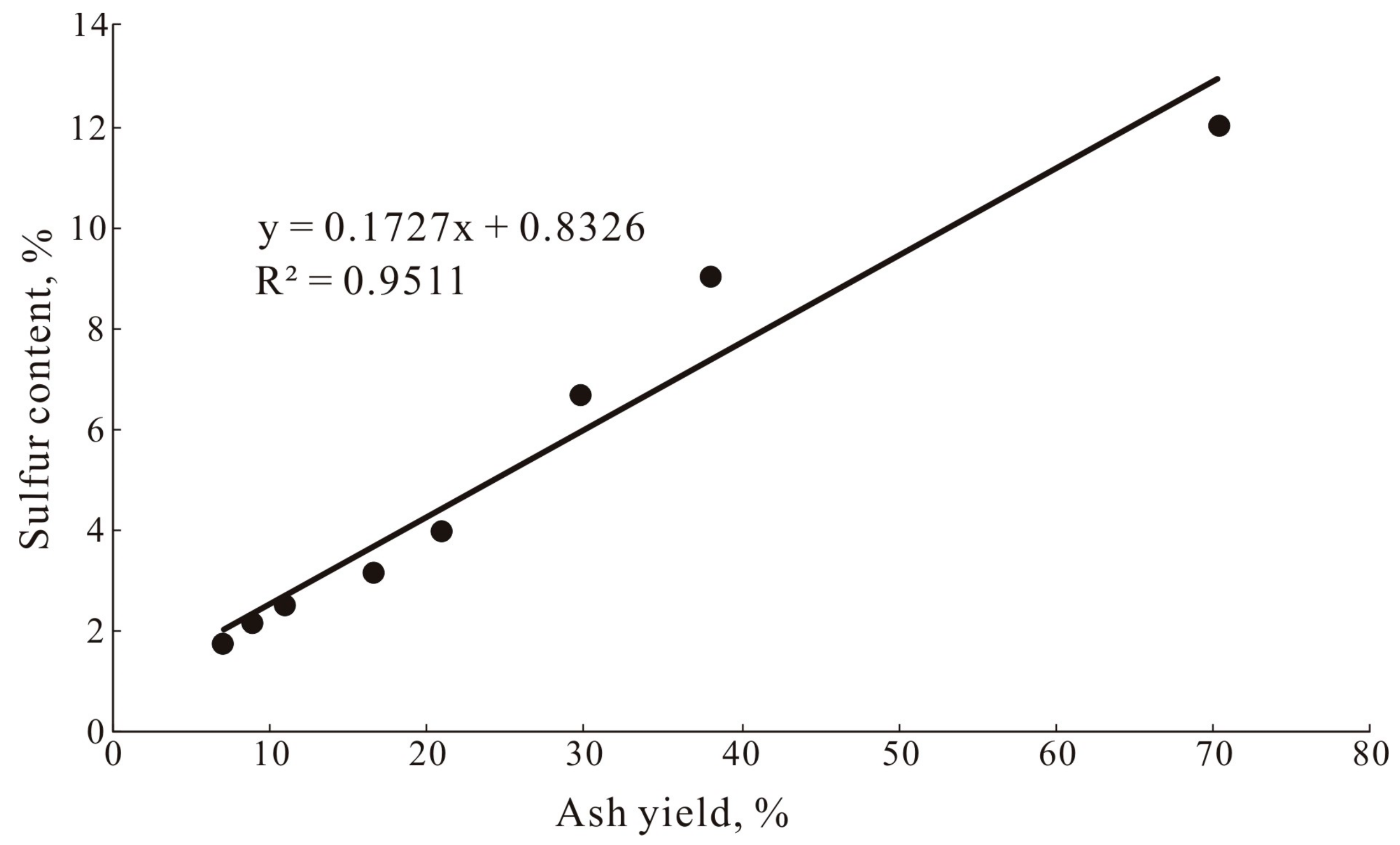
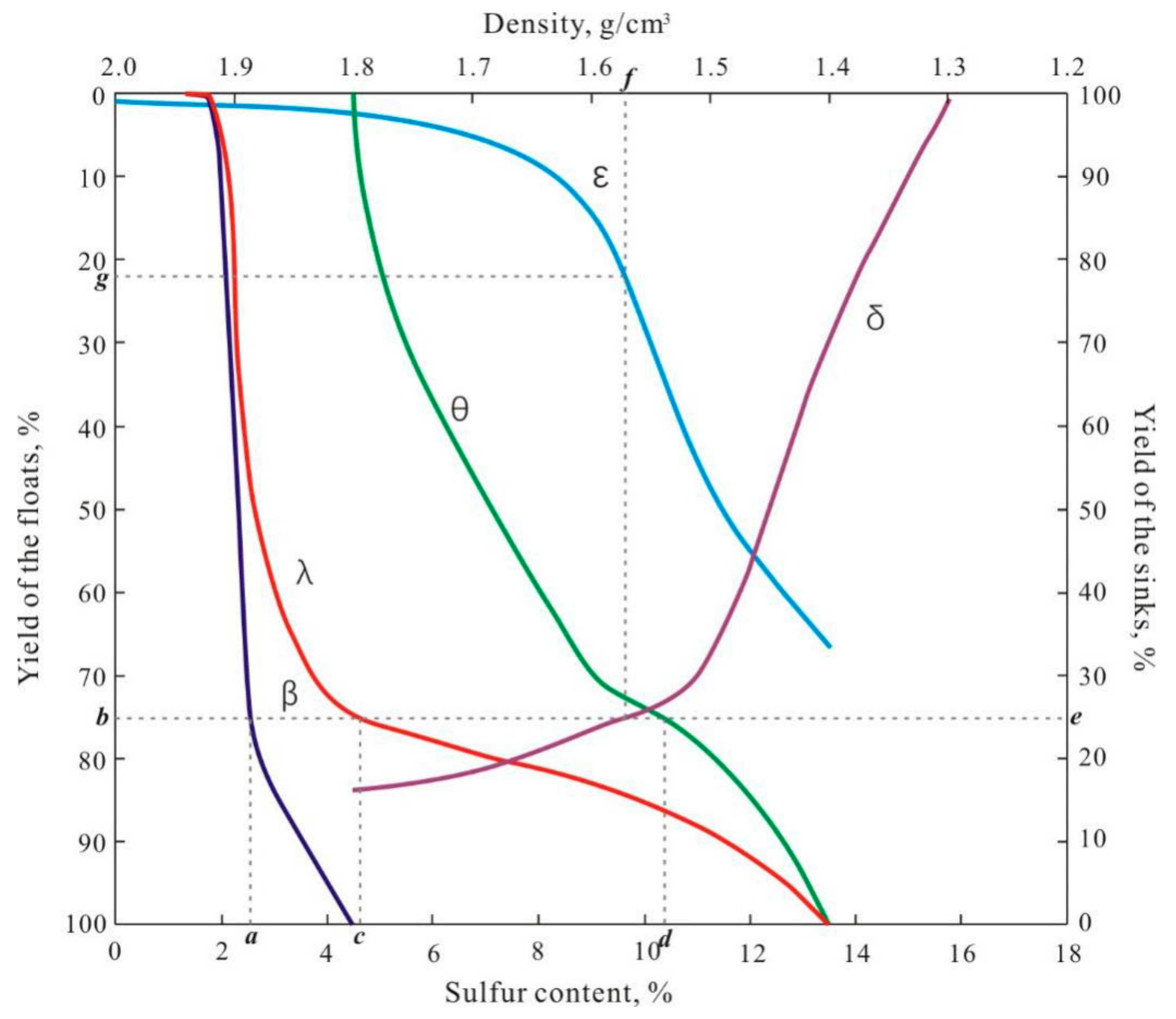
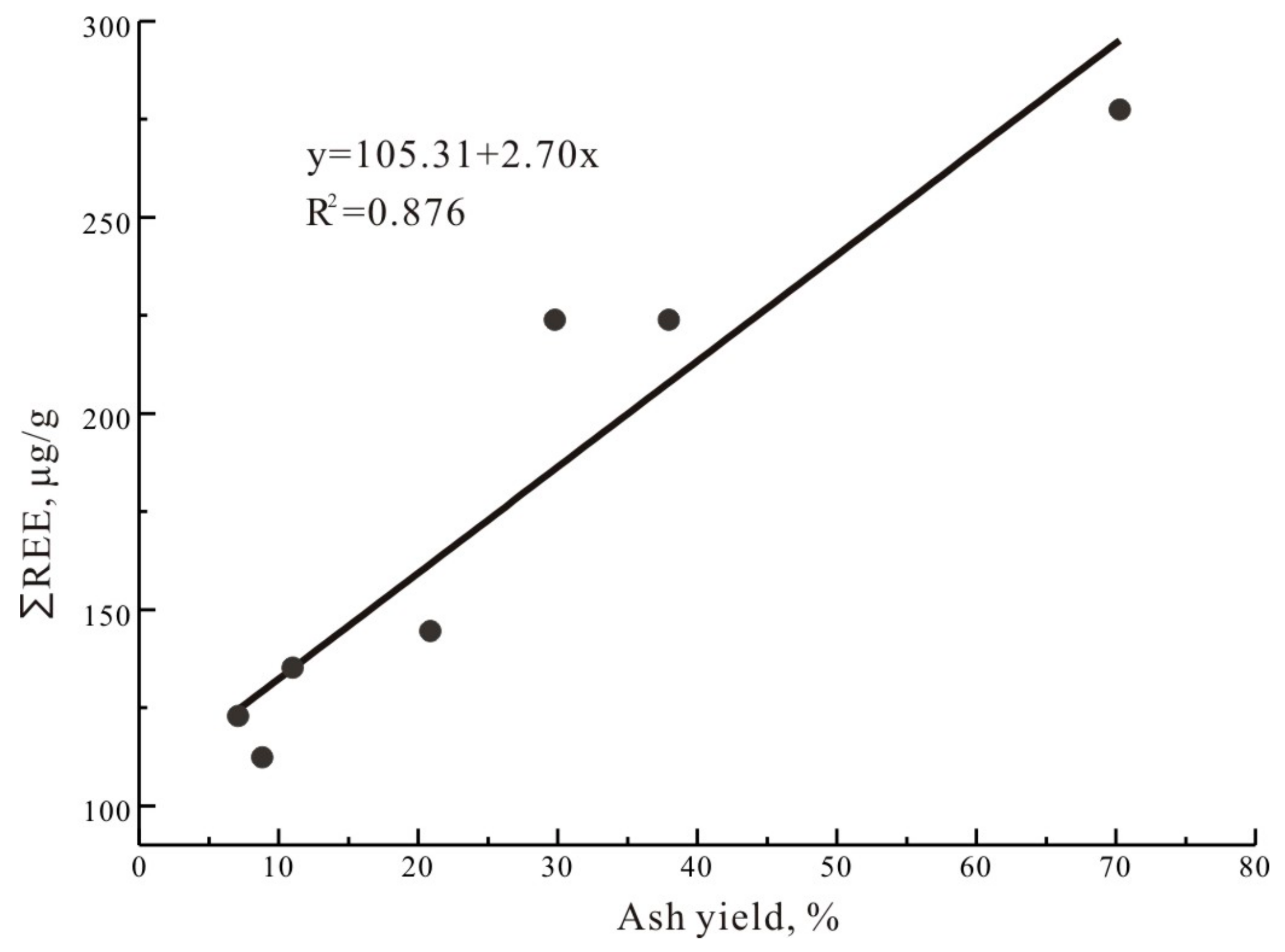
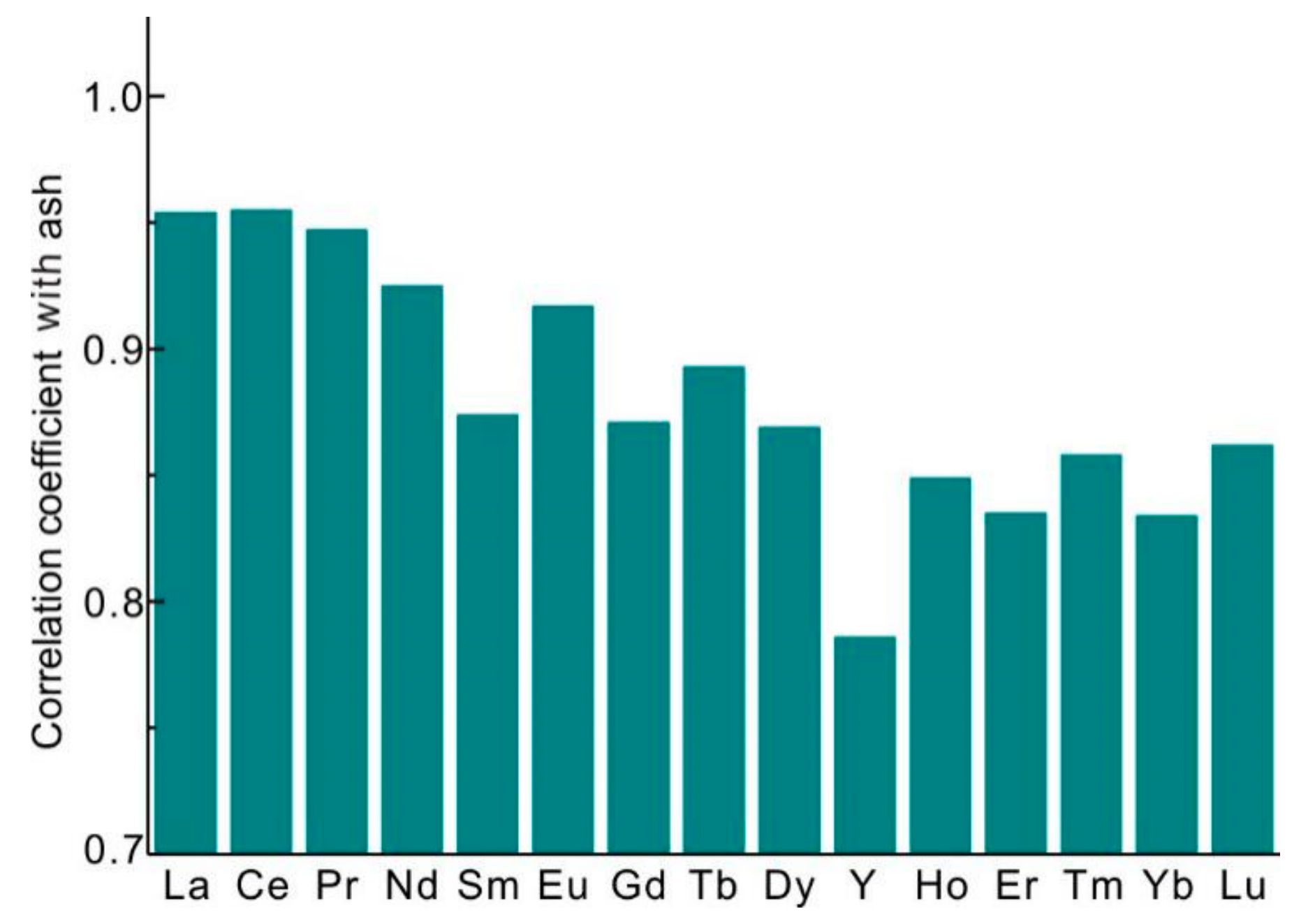
| Size Grade/mm | Yield/% | Oversize Accumulation Yield/% | Moisture/% | Ash/% | Sulfur/% |
|---|---|---|---|---|---|
| 50~25 | 21.63 | 21.63 | 4.57 | 27.45 | 6.74 |
| 25~13 | 17.57 | 39.20 | 4.16 | 24.21 | 4.72 |
| 13~6 | 16.85 | 56.05 | 4.46 | 22.10 | 3.66 |
| 6~3 | 10.81 | 66.86 | 4.47 | 18.68 | 3.35 |
| 3~0.5 | 17.38 | 84.24 | 4.50 | 16.86 | 3.04 |
| −0.5 | 15.76 | 100.00 | 4.56 | 16.58 | 3.23 |
| Total | 100 | 4.45 | 22.48 | 4.50 |
| Density(g/cm3) | Yield% | Ash% | Sulfur% | Accumulation | Δ ± 0.1(g/cm3) | ||||||
|---|---|---|---|---|---|---|---|---|---|---|---|
| Float | Sink | ||||||||||
| Yield% | Ash% | Sulfur% | Yield% | Ash% | Sulfur% | Density(g/cm3) | Yield% | ||||
| <1.30 | 0.99 | 7.11 | 1.80 | 0.99 | 7.11 | 1.80 | 100.00 | 22.40 | 4.47 | 1.30 | 29.15 |
| 1.30~1.40 | 28.16 | 8.83 | 2.19 | 29.15 | 8.77 | 2.18 | 99.01 | 22.55 | 4.50 | 1.40 | 66.56 |
| 1.40~1.50 | 38.40 | 11.02 | 2.56 | 67.55 | 10.05 | 2.39 | 70.85 | 28.00 | 5.41 | 1.50 | 47.49 |
| 1.50~1.60 | 9.09 | 20.88 | 4.00 | 76.64 | 11.33 | 2.59 | 32.45 | 48.10 | 8.79 | 1.60 | 14.07 |
| 1.60~1.70 | 4.98 | 29.80 | 6.73 | 81.62 | 12.46 | 2.84 | 23.36 | 58.69 | 10.65 | 1.70 | 7.11 |
| 1.70~1.80 | 2.13 | 37.97 | 9.07 | 83.75 | 13.11 | 3.00 | 18.38 | 66.52 | 11.71 | 1.80 | |
| >1.80 | 16.25 | 70.26 | 12.06 | 100.00 | 22.40 | 4.47 | 16.25 | 70.26 | 12.06 | ||
| Sub-total | 100.00 | 22.40 | 4.47 | ||||||||
| Sludge | 1.19 | 16.54 | 3.21 | ||||||||
| Sum | 100.00 | 22.33 | 4.45 | ||||||||
| Sample | HF-001 | HF-002 | HF-003 | HF-004 | HF-005 | HF-006 | HF-007 | HF-008 | HF-009 |
|---|---|---|---|---|---|---|---|---|---|
| Density, g/cm3 | ROM | <1.30 | 1.30–1.40 | 1.40–1.50 | 1.50–1.60 | 1.60–1.70 | 1.70–1.80 | >1.80 | Sludge |
| Yield, % | 100 | 0.99 | 28.16 | 38.4 | 9.09 | 4.98 | 2.13 | 16.25 | 1.19 |
| Ash, % | 22.38 | 7.11 | 8.83 | 11.02 | 20.88 | 29.80 | 37.97 | 70.26 | 16.54 |
| Sulfur, % | 4.45 | 1.80 | 2.19 | 2.56 | 4.00 | 6.73 | 9.07 | 12.06 | 3.21 |
| Li | 35.4 | 36.1 | 33.9 | 41.1 | 42.5 | 32.3 | 55.4 | 56.8 | 33.4 |
| Be | 1.57 | 1.43 | 1.34 | 1.69 | 1.48 | 1.2 | 1.75 | 1.91 | 1.62 |
| P | 120 | 80 | 50 | 80 | 70 | 100 | 150 | 230 | 170 |
| V | 109 | 67 | 75 | 108 | 146 | 151 | 208 | 136 | 163 |
| Cr | 30 | 17 | 19 | 36 | 36 | 34 | 51 | 41 | 45 |
| Mn | 92 | 11 | 9 | 22 | 127 | 400 | 279 | 296 | 128 |
| Co | 13.6 | 5.4 | 5.5 | 12 | 16.9 | 17 | 17.6 | 23.2 | 59.8 |
| Ni | 16.4 | 6.3 | 9.6 | 17.1 | 27.1 | 21.2 | 33.6 | 28.9 | 32.4 |
| Cu | 26.0 | 11.3 | 12.4 | 17.1 | 38.8 | 27.4 | 44.1 | 52.8 | 27.0 |
| Ga | 7.66 | 6.06 | 5.88 | 6.60 | 8.80 | 8.67 | 12.85 | 18.85 | 9.49 |
| Rb | 3.9 | 0.7 | 2 | 2.2 | 5.6 | 5.5 | 8.8 | 12.6 | 4.8 |
| Sr | 62.6 | 32.8 | 31.2 | 40.7 | 64.3 | 124.0 | 116.0 | 115.0 | 92.8 |
| Y | 18.6 | 17.6 | 16 | 19.8 | 22.8 | 26.2 | 28.3 | 28.5 | 26.6 |
| Zr | 144 | 110 | 74 | 142 | 137 | 208 | 257 | 324 | 228 |
| Nb | 19.8 | 15.1 | 10.0 | 16.0 | 15.7 | 24.5 | 41.4 | 61.9 | 28.4 |
| Mo | 26.6 | 8.1 | 14.2 | 20.8 | 41.7 | 37.0 | 52.5 | 25.4 | 37.4 |
| Ag | 0.06 | 0.01 | 0.01 | 0.01 | 0.03 | 0.02 | 0.01 | 0.05 | 0.03 |
| Cd | 0.32 | 0.08 | 0.17 | 0.27 | 0.63 | 0.47 | 0.82 | 0.66 | 0.37 |
| In | 0.053 | 0.054 | 0.048 | 0.044 | 0.055 | 0.079 | 0.074 | 0.088 | 0.061 |
| Sn | 2 | 1 | 3 | 3 | 2 | 1 | 1 | 1 | 1 |
| Sb | 0.55 | 0.2 | 0.18 | 0.24 | 0.55 | 0.59 | 1.03 | 1.62 | 0.72 |
| Te | <0.05 | <0.05 | 0.05 | <0.05 | 0.12 | 0.05 | 0.05 | 0.07 | 0.05 |
| Cs | 0.45 | 0.08 | 0.22 | 0.22 | 0.71 | 0.63 | 1.07 | 1.90 | 0.56 |
| Ba | 44.4 | 9.4 | 10.7 | 33.5 | 54.7 | 88.8 | 195.5 | 192 | 54.3 |
| La | 26.5 | 23.4 | 21.3 | 24.9 | 24.5 | 41.8 | 42.8 | 55.9 | 29.7 |
| Ce | 52.6 | 45.6 | 41.5 | 49.5 | 52.4 | 85.5 | 84.6 | 112.0 | 60.9 |
| Pr | 6.02 | 4.91 | 4.54 | 5.56 | 6.13 | 9.60 | 9.58 | 12.15 | 6.95 |
| Nd | 20.4 | 16.6 | 16.0 | 19.0 | 21.3 | 34.7 | 33.3 | 41.0 | 24.0 |
| Sm | 3.85 | 3.12 | 2.95 | 3.81 | 4.22 | 7.33 | 6.51 | 7.71 | 4.62 |
| Eu | 0.71 | 0.56 | 0.54 | 0.60 | 0.76 | 1.20 | 1.19 | 1.41 | 0.85 |
| Gd | 3.73 | 2.92 | 2.93 | 3.62 | 3.72 | 5.99 | 5.81 | 6.47 | 4.48 |
| Tb | 0.48 | 0.43 | 0.37 | 0.46 | 0.54 | 0.75 | 0.82 | 0.91 | 0.66 |
| Dy | 3.08 | 2.64 | 2.48 | 3.19 | 3.26 | 4.19 | 4.85 | 5.12 | 4.07 |
| Ho | 0.64 | 0.57 | 0.52 | 0.7 | 0.69 | 0.81 | 0.97 | 0.99 | 0.81 |
| Er | 1.74 | 1.55 | 1.44 | 1.78 | 1.89 | 2.20 | 2.51 | 2.57 | 2.23 |
| Tm | 0.25 | 0.23 | 0.21 | 0.25 | 0.27 | 0.32 | 0.37 | 0.39 | 0.33 |
| Yb | 1.63 | 1.55 | 1.40 | 1.78 | 1.79 | 2.02 | 2.36 | 2.39 | 2.06 |
| Lu | 0.26 | 0.24 | 0.21 | 0.27 | 0.27 | 0.30 | 0.35 | 0.37 | 0.31 |
| Hf | 3.4 | 2.7 | 1.9 | 3.6 | 3.5 | 4.7 | 6.5 | 9.3 | 5.2 |
| Ta | 1.2 | 0.6 | 0.5 | 0.6 | 1.0 | 1.8 | 3.6 | 5.6 | 1.8 |
| W | 1 | 3 | 2 | 4 | 7 | 10 | 11 | 13 | 13 |
| Re | 0.052 | 0.005 | 0.01 | 0.04 | 0.132 | 0.117 | 0.143 | 0.025 | 0.082 |
| Pb | 9.2 | 5.1 | 4.8 | 6.5 | 9.8 | 9.3 | 15.8 | 16.4 | 9.4 |
| Bi | 0.27 | 0.18 | 0.16 | 0.20 | 0.21 | 0.16 | 0.25 | 0.27 | 0.21 |
| Th | 5.51 | 3.38 | 2.80 | 4.61 | 4.88 | 6.42 | 11.25 | 16.50 | 6.57 |
| U | 20.8 | 6.0 | 10.0 | 18.0 | 31.4 | 33.0 | 43.2 | 16.9 | 27.4 |
| REE | 140.49 | 121.92 | 112.39 | 135.22 | 144.54 | 222.91 | 224.32 | 277.88 | 168.57 |
| L/H | 3.62 | 3.40 | 3.40 | 3.25 | 3.10 | 4.21 | 3.84 | 4.82 | 3.06 |
| Cs | Ga | Ta | Th | Rb | Sb | Nb | Hf | Ba | Pb |
|---|---|---|---|---|---|---|---|---|---|
| 0.983 | 0.974 | 0.969 | 0.969 | 0.967 | 0.962 | 0.950 | 0.943 | 0.903 | 0.901 |
| In | Cu | Zr | P | Li | Bi | Sr | Mn | Cd | Ag |
| 0.892 | 0.887 | 0.884 | 0.825 | 0.778 | 0.769 | 0.756 | 0.740 | 0.737 | 0.735 |
| W | Be | Ni | Cr | V | Mo | U | Re | Co | Sn |
| 0.725 | 0.596 | 0.593 | 0.548 | 0.486 | 0.354 | 0.293 | 0.160 | 0.150 | -0.488 |
| Element | Cwt | Dc | Dm | Dg | Ds |
|---|---|---|---|---|---|
| Li | 40.20 | 61.19 | 5.77 | 19.11 | 13.93 |
| Be | 1.59 | 61.56 | 5.08 | 16.26 | 17.09 |
| P | 109.66 | 39.44 | 6.21 | 28.37 | 25.98 |
| V | 119.36 | 53.37 | 8.33 | 15.41 | 22.89 |
| Cr | 34.23 | 55.00 | 6.76 | 16.20 | 22.04 |
| Mn | 101.86 | 18.50 | 21.13 | 39.31 | 21.06 |
| Co | 20.63 | 31.26 | 4.93 | 15.21 | 48.59 |
| Ni | 20.63 | 47.59 | 7.15 | 18.95 | 26.32 |
| Cu | 24.99 | 45.63 | 7.68 | 28.58 | 18.11 |
| Ga | 8.93 | 47.07 | 6.58 | 28.55 | 17.81 |
| Rb | 4.49 | 35.63 | 8.54 | 37.92 | 17.90 |
| Sr | 63.76 | 39.93 | 11.29 | 24.40 | 24.39 |
| Y | 21.85 | 54.69 | 7.27 | 17.64 | 20.40 |
| Zr | 169.23 | 43.73 | 7.79 | 25.90 | 22.58 |
| Nb | 23.65 | 37.08 | 7.40 | 35.40 | 20.12 |
| Mo | 25.37 | 52.03 | 9.72 | 13.54 | 24.71 |
| Ag | 0.02 | 38.15 | 4.86 | 32.69 | 24.30 |
| Cd | 0.36 | 48.50 | 9.46 | 24.81 | 17.24 |
| In | 0.06 | 52.83 | 8.10 | 21.02 | 18.05 |
| Sn | 2.18 | 83.42 | 2.71 | 6.19 | 7.67 |
| Sb | 0.54 | 29.77 | 7.84 | 40.23 | 22.15 |
| Cs | 0.57 | 30.80 | 7.88 | 44.91 | 16.40 |
| Ba | 59.65 | 29.22 | 11.98 | 43.54 | 15.26 |
| La | 30.03 | 49.95 | 8.30 | 25.18 | 16.58 |
| Ce | 60.29 | 49.58 | 8.37 | 25.13 | 16.93 |
| Pr | 6.72 | 49.77 | 8.45 | 24.45 | 17.33 |
| Nd | 23.17 | 49.95 | 8.76 | 23.94 | 17.36 |
| Sm | 4.49 | 50.20 | 9.34 | 23.22 | 17.24 |
| Eu | 0.78 | 48.50 | 9.03 | 24.31 | 18.16 |
| Gd | 4.13 | 52.09 | 8.51 | 21.21 | 18.19 |
| Tb | 0.56 | 49.90 | 8.18 | 22.08 | 19.84 |
| Dy | 3.50 | 53.35 | 7.41 | 19.77 | 19.47 |
| Ho | 0.72 | 55.68 | 7.02 | 18.52 | 18.78 |
| Er | 1.92 | 55.35 | 7.07 | 18.11 | 19.47 |
| Tm | 0.28 | 54.22 | 7.10 | 18.88 | 19.80 |
| Yb | 1.84 | 56.83 | 6.83 | 17.57 | 18.77 |
| Lu | 0.28 | 56.69 | 6.69 | 17.97 | 18.65 |
| Hf | 4.32 | 43.56 | 7.17 | 29.10 | 20.16 |
| Ta | 1.59 | 24.55 | 8.72 | 47.72 | 19.01 |
| W | 6.85 | 33.61 | 8.90 | 25.68 | 31.81 |
| Re | 0.05 | 50.65 | 14.87 | 6.81 | 27.67 |
| Pb | 8.45 | 47.20 | 7.88 | 26.27 | 18.65 |
| Bi | 0.20 | 58.93 | 5.49 | 18.12 | 17.46 |
| Th | 6.33 | 39.95 | 7.36 | 35.28 | 17.41 |
| U | 19.54 | 53.87 | 10.92 | 11.70 | 23.51 |
| REE | 160.57 | 50.76 | 8.23 | 23.41 | 17.60 |
© 2018 by the authors. Licensee MDPI, Basel, Switzerland. This article is an open access article distributed under the terms and conditions of the Creative Commons Attribution (CC BY) license (http://creativecommons.org/licenses/by/4.0/).
Share and Cite
Cheng, W.; Yang, R.; Zhang, Q.; Luo, B.; Jia, Y. Washability and Distribution Behaviors of Trace Elements of a High-Sulfur Coal, SW Guizhou, China. Minerals 2018, 8, 59. https://doi.org/10.3390/min8020059
Cheng W, Yang R, Zhang Q, Luo B, Jia Y. Washability and Distribution Behaviors of Trace Elements of a High-Sulfur Coal, SW Guizhou, China. Minerals. 2018; 8(2):59. https://doi.org/10.3390/min8020059
Chicago/Turabian StyleCheng, Wei, Ruidong Yang, Qin Zhang, Baojiang Luo, and Yujuan Jia. 2018. "Washability and Distribution Behaviors of Trace Elements of a High-Sulfur Coal, SW Guizhou, China" Minerals 8, no. 2: 59. https://doi.org/10.3390/min8020059
APA StyleCheng, W., Yang, R., Zhang, Q., Luo, B., & Jia, Y. (2018). Washability and Distribution Behaviors of Trace Elements of a High-Sulfur Coal, SW Guizhou, China. Minerals, 8(2), 59. https://doi.org/10.3390/min8020059





